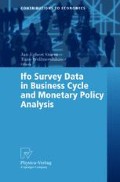We thank Wolfgang Meister for sharing his knowledge regarding data revisions in Germany and his excellent research assistance, and Theo Eicher for his comments. This research project was started while Jan-Egbert Sturm was associated with and Jan Jacobs was visiting the Ifo Institute for Economic Research, Munich, Germany. The present version of the paper has benefited from comments following presentations at the Victor Zarnowitz Seminar, RWI, Essen, Germany, June 2003, and the Academic Use of Ifo Survey Data Conference, Munich, Germany, December 2003.
Access this chapter
Tax calculation will be finalised at checkout
Purchases are for personal use only
Preview
Unable to display preview. Download preview PDF.
References
Akaike, H. (1969): “Fitting autoregressive models for prediction,” Annals of the Institute of Statistical Mathematics, 21, 243–247.
— (1970): “Statistical predictor identification,” Annals of the Institute of Statistical Mathematics, 22, 203–217.
Bajada, C. (2003): “The effects of inflation and the business cycle on revisions of macroeconomic data,” The Australian Economic Review, 25, 276–286.
Croushore, D., and T. Stark (1999): “A real-time data set for macreconomists,” Working Paper No. 99-4, Federal Reserve Bank of Philadelphia.
— (2001): “A real-time data set for macroeconomists,” Journal of Econometrics, 105, 111–130.
Egginton, D., A. Pick, and S. P. Vahey (2001): ““Keep it real!”: a real-time UK data set,” mimeo, University of Cambridge.
Fritsche, U., and S. Stephan (2002): “Leading indicators of German business cycles: An assessment of properties,” Journal of Economics and Statistics, 222(3), 289–315.
Hüfner, F., and M. Schröder (2002): “Forecasting economic activity in Germany—How useful are sentiment indicators?,” Discussion Paper 02-56, ZEW.
Jung, S. (2003): “Revisionsanalyse des deutschen Produktionsindex (The revision history of the production index in Germany),” Wirtschaft und Statistik, 2003(9), 819–826.
Langmantel, E. (1999): “Das Ifo Geschäftsklima als Indikator für die Prognose des Bruttoinlandsprodukts,” ifo Schnelldienst, 52(16–17), 16–21.
Nerb, G. (2004): “Survey activity of the Ifo institute,” in Ifo Survey Data in Business Cycle and Monetary Policy Analysis, ed. by J.-E. Sturm, and T. Wollmershäuser. Physica Verlag.
Nierhaus, W., and J. Sturm (2003): “Methoden der Konjunkturprognose,” ifo Schnelldienst, 56(4), 7–23.
Oppenländer, K. (ed.) (1997): Business cycle indicators. Avebury, Aldershot etc.
Statistisches Bundesamt (various issues): “Indizes der Produktion und der Arbeitsproduktivität im Produzierenden Gewerbe,” Fachserie 4, Reihe 2.1, Statistisches Bundesamt.
Stone, A., and S. Wardrop (2002): “Real-time national accounts data,” Research Discussion Paper 2002-15, Economic Research Department, Reserve Bank of Australia.
Strigel, W. (1990): “Business cycle surveys: a new quality in economic statistics,” in Analyzing modern business cycles. Essays honoring G.H. Moore, ed. by P. Klein, chap. 5, pp. 69–84. M.E. Sharpe, Inc., Arnouk (NY) and London.
Swanson, N., E. Ghysels, and M. Callan (1999): “A multivariate time series analysis of the data revision process for industrial production and the Composite Leading Indicator,” in Cointegration, Causality, and Forecasting. A Festschrift in Honour of Clive W.J. Granger, ed. by R. Engle, and H. White. Oxford University Press, Oxford.
Theil, H. (1955): “Recent experiences with the Munich business test: an expository article,” Econometrica, 23, 184–192.
Zarnowitz, V. (1992): Business cycles: theory, history, indicators and forecasting, vol. 27 of NBER Studies in Business Cycles. The University of Chicago Press, Chicago and London.
Author information
Authors and Affiliations
Corresponding author
Editor information
Editors and Affiliations
Rights and permissions
Copyright information
© 2005 Physica-Verlag Heidelberg
About this paper
Cite this paper
Jacobs, J., Sturm, JE. (2005). Do Ifo Indicators Help Explain Revisions in German Industrial Production?. In: Sturm, JE., Wollmershäuser, T. (eds) Ifo Survey Data in Business Cycle and Monetary Policy Analysis. Contributions to Economics. Physica-Verlag HD. https://doi.org/10.1007/3-7908-1605-1_5
Download citation
DOI: https://doi.org/10.1007/3-7908-1605-1_5
Publisher Name: Physica-Verlag HD
Print ISBN: 978-3-7908-0174-3
Online ISBN: 978-3-7908-1605-1
eBook Packages: Business and EconomicsEconomics and Finance (R0)

